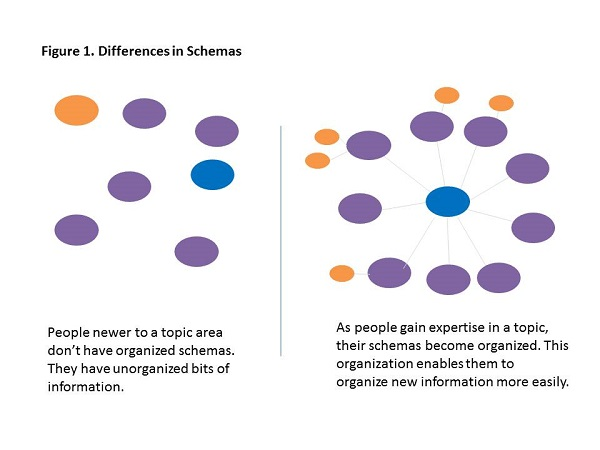ATD Blog
Science of Learning 101: Reducing the Wrong Types of Mental Effort in Instruction
Thu Jul 07 2016

Bookmark
I’ve heard people say that L&D professionals don’t have good research to guide their best practices. Not so! Granted, research may be hard to find or access. What’s more, it’s not always easy to interpret. (So, thank you ATD for allowing me to do so!) But the fact remains that we do have some terrific research to use in organizational learning.
Case in point: One of the most highly researched aspects of instruction is the issue of cognitive load. Cognitive load informs the L&D field about the constraints on working memory (short-term memory used for immediate, conscious mental processing) that can affect how well people can think and learn during a specific situation. It applies to every learning situation.
Schemas Support Memory
George Miller's “magical number 7, plus or minus 2” research showed that short-term memory is limited in the number of elements it can hold in memory. He showed that when short-term memory becomes overloaded, thinking and learning is hindered or even stopped.
Meanwhile, knowledge is stored in long-term memory in mental structures called schemas, and long-term memory appears to have an unlimited capacity. People learning new subject matter do not have effective schemas, and they are overload more easily. Experts, however, have broad schemas to hold their knowledge in long-term memory. (See Figure 1.)

When people are in the process of learning, new information comes up against the limits of short-term memory. Here are some typical ways that working memory can become overloaded during instruction, especially for people new to a topic:
A. The content contains technical terms or acronyms that are new but aren’t explained.
B. Audio narration reads what is on the page or slides, word for word.
C. Unessential content and images are included.
D. The third part of the practice for the new system includes 13 steps and each step has diagrams, explanations, and definitions.
Three Types of Cognitive Load
Let’s look at the three types of cognitive load: intrinsic, germane, and extraneous. Intrinsic cognitive load comes from the course material itself; germane cognitive load; and extraneous cognitive load can be (and should be) controlled by the instructor or course developer.
Intrinsic Cognitive Load
Intrinsic cognitive load is the inherent difficulty of the content itself. Some examples:
Pivot tables are more difficult than summing a list of numbers in Excel.
Factor analysis is more difficult than t-tests in statistics.
Writing a book is more difficult than writing an email.
Although we cannot change intrinsic cognitive load, we can manage and support people through the difficulties with germane cognitive load. For instance, we see that in Example D above, a learner must coordinate multiple steps with different images and text. This creates potential for confusion, because the learner must hold quite a lot in memory at once. So, when designing this activity, what can designers do to help the learner manage this cognitive load and process what they are doing—rather than just read from the manual? That’s where germane cognitive load comes in.
Germane Cognitive Load
Germane cognitive load occurs when a person processes information in a way that contributes to learning. Germane cognitive load can positively modify intrinsic cognitive load. This includes good examples, chunking content, and other activities that help people learn.
For instance, we can help build schema connections by grouping practice activities and information. When we build in good examples and allow the learner to select the Hint or Procedure Manual button while practicing, we are adding germane cognitive load that helps the difficulty in D. There are other ways to make difficult steps easier, such as making sure that text descriptions are inside or next to diagrams, not outside of diagrams.
Extraneous Cognitive Load
When information or elements get in the way of learning and waste mental effort, this is called extraneous cognitive load. Extraneous cognitive load needs to be eliminated.
Extraneous cognitive load is caused by the design of the instruction, making it more difficult to learn. All of the examples above except D point to cases in which the designer or instructor should have done something different, but chose not to. For example, we know from Mayer and Moreno’s research that reading text on the screen word for word causes cognitive load. It’s better to either shorten the words on the screen (a lot) or show a picture and then use audio narration to discuss the picture.
Putting It All Together
Intrinsic, germane, and extraneous load add together. Because we cannot control intrinsic load and germane load is helpful, we must reduce extrinsic load. Don’t forget, people at work are dealing with plenty of cognitive load in their work. Think of your own job and how much you have to learn and think every day. If we aren’t able to reduce the load, the ability to learn is greatly reduced.
Next month’s post will explore ways to improve germane cognitive load and reduce extraneous cognitive load.
References
Chandler, P., & Sweller, J. (1991). Cognitive load theory and the format of instruction. Cognition and Instruction, 8, 293–332.
Mayer, R. E., & Moreno, R. (2003). Nine ways to reduce cognitive load in multimedia learning. Educational Psychologist, 38(1), 43–52.
Miller, G. A. (1955). [The magical number seven, plus or minus two some limits on our capacity for processing information](http://www.psych.utoronto.ca/users/peterson/psy430s2001/Miller GA Magical Seven Psych Review 1955.pdf). Psychological Review, 101(2), 343–352.
Sweller, J. (1994). Cognitive load theory, learning difficulty, and instructional design. Learning and Instruction, 4, 295–312.
More from ATD

